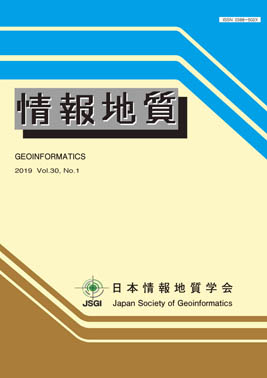Volume 30, Issue 4
Displaying 1-11 of 11 articles from this issue
- |<
- <
- 1
- >
- >|
Cover (GEOINFORMATICS 2019 Vol30. No.4)
-
2019 Volume 30 Issue 4 Pages h1-h4
Published: December 25, 2019
Released on J-STAGE: December 25, 2019
Download PDF (454K)
CONTENTS
-
2019 Volume 30 Issue 4 Pages 139-140
Published: December 25, 2019
Released on J-STAGE: December 25, 2019
Download PDF (379K)
Preface
-
2019 Volume 30 Issue 4 Pages 141-146
Published: December 25, 2019
Released on J-STAGE: December 25, 2019
Download PDF (399K)
Review
-
Article type: Review
2019 Volume 30 Issue 4 Pages 147-159
Published: December 25, 2019
Released on J-STAGE: December 25, 2019
Download PDF (1503K) -
Article type: Review
2019 Volume 30 Issue 4 Pages 161-179
Published: December 25, 2019
Released on J-STAGE: December 25, 2019
Download PDF (2406K) -
Article type: Review
2019 Volume 30 Issue 4 Pages 181-195
Published: December 25, 2019
Released on J-STAGE: December 25, 2019
Download PDF (3920K) -
Article type: Review
2019 Volume 30 Issue 4 Pages 197-208
Published: December 25, 2019
Released on J-STAGE: December 25, 2019
Download PDF (2151K) -
Article type: Review
2019 Volume 30 Issue 4 Pages 209-236
Published: December 25, 2019
Released on J-STAGE: December 25, 2019
Download PDF (11963K)
Development of System and Software
-
Article type: Development of System and Software
2019 Volume 30 Issue 4 Pages 237-251
Published: December 25, 2019
Released on J-STAGE: December 25, 2019
Download PDF (15459K)
Contents of Geoinformatics Vol.30
-
2019 Volume 30 Issue 4 Pages 253-256
Published: December 25, 2019
Released on J-STAGE: December 25, 2019
Download PDF (239K)
Manuscript Submission Form, Guaranty, Membership Application Form, Editorial note
-
2019 Volume 30 Issue 4 Pages 257-261
Published: December 25, 2019
Released on J-STAGE: December 25, 2019
Download PDF (390K)
- |<
- <
- 1
- >
- >|
